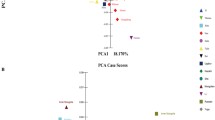Abstract
To evaluate the applicability of 23 autosomal STR loci (D10S1248, D11S4463, D12ATA63, D14S1434, D17S1301, D18S853, D1GATA113, D1S1627, D6S1017, D20S1082, D20S482, D17S974, D22S1045, D1S1677, D2S1776, D2S441, D3S4529, D4S2408, D9S1122D5S2500, D6S474, D18S51, D9S2157) included in DNA Typer™ 25 Kit for individual identification and parentage testing, allele frequencies and forensic efficiency parameters were first obtained from healthy, unrelated 506 Chongqing Tujia individuals. A total of 1012 alleles were identified in 23 STR loci, and allele frequencies ranged from 0.001 to 0.5761. The combined power of discrimination (CPD) and the combined power of exclusion (CPE) of the 23 STR loci were 0.999999999999999999999753 and 0.99999967, respectively. These results suggested that 23 autosomal STR loci could be used as an effective tool for forensic application in Chongqing Tujia population. Comprehensive comparisons were conducted based on the analysis of genetic distance, principal component analysis (PCA), multidimensional scaling plot (MDS), and phylogenetic tree to explore the interpopulation genetic relationship. Our results revealed that Chongqing Tujia keeps the more relatively genetic similarity with Hunan Han, Hubei Tujia, and Sichuan Han, which could be interpreted by that those populations were originated from the same ethnic ancestor or genetic communication were happened in adjacent areas.
Similar content being viewed by others
References
Xue B, Yao YR, Wang CL et al (2019) Development of a new 25plex STRs typing system for forensic application. Electrophoresi 40:1662–1676 https://orcid.org/0000-0003-2185-5043
Zhang L, Li JB et al (2019) Genetic diversity of 23 STR loci in Guangxi Zhuang population and its phylogenetic relationship with other 25 populations. Ann Hum Biol. https://doi.org/10.1080/03014460.2019.1673481
Bär W, Brinkmann B, Budowle B, Carracedo A, Gill P, Lincoln P, Mayr W, Olaisen B (1997) DNA recommendations. Further report of the DNA commission of the ISFH regarding the use of short tandem repeat systems. International Society for Forensic Haemogenetics. Int J Legal Med 110:175–176. https://doi.org/10.1007/s004140050061
Zhao F, Wu X, Cai G, Xu C et al (2003) The application of Modified-Powerstates software in forensic biostatistics. Chin J Forensic Med 18:297–298. https://doi.org/10.13618/j.issn.1001-5728.2003.05.017
Excoffier L, Laval G, Schneider S et al (2005) Arlequin (version 3.0): an integrated software package for population genetics data analysis. Bioinf 1:47–50 http://cmpg.unibe.ch/software/arlequin3
Felsenstein J et al (2009) PHYLIP (phylogeny inference package) version 3.69. Department of Genome Sciences, University of Washington, Seattle. https://doi.org/10.1086/416571
Hall BG et al (2013) Building phylogenetic trees from molecular data with MEGA. Mol Biol Evol 30:1229–1235. https://doi.org/10.1093/molbev/mst012
François O, Currat M, Ray N, Han E, Excoffier L, Novembre J (2010) Principal component analysis under population genetic models of range expansion and admixture. Mol Biol Evol 27:1257–1268. https://doi.org/10.1093/molbev/msp010
Shu L, Li L, Yu G, Yu B, Liu Y, Li S, Jin L, Yan S (2015) Genetic analysis of 17 Y-STR loci in Han, Dong, Miao and Tujia populations from Hunan province, Central-Southern China. Forensic Sci Int Genet 19:250–251. https://doi.org/10.1016/j.fsigen.2015.07.007
Yang Y, Jing YT, Zhang GD, Fang XD, Yan JW (2014) Genetic analysis of 17 Y-chromosomal STR loci of Chinese Tujia ethnic group residing in Youyang Region of Southern China. Legal Med 16:173–175. https://doi.org/10.1016/j.legalmed.2014.01.010
Acknowledgements
We thank all the participants in this study.
Data accessibility
The authors confirm that all the data in the research are available.
Funding
This project is supported by the Institute of Forensic Science, Ministry of Public Security, P.R. China.
Author information
Authors and Affiliations
Corresponding author
Ethics declarations
Conflict of interest
The authors declare that they have no conflict of interest.
Additional information
Publisher’s note
Springer Nature remains neutral with regard to jurisdictional claims in published maps and institutional affiliations.
Rights and permissions
About this article
Cite this article
Zhang, L., Yang, F., Bai, X. et al. Genetic polymorphism analysis of 23 STR loci in the Tujia population from Chongqing, Southwest China. Int J Legal Med 135, 761–763 (2021). https://doi.org/10.1007/s00414-020-02287-z
Received:
Accepted:
Published:
Issue Date:
DOI: https://doi.org/10.1007/s00414-020-02287-z




